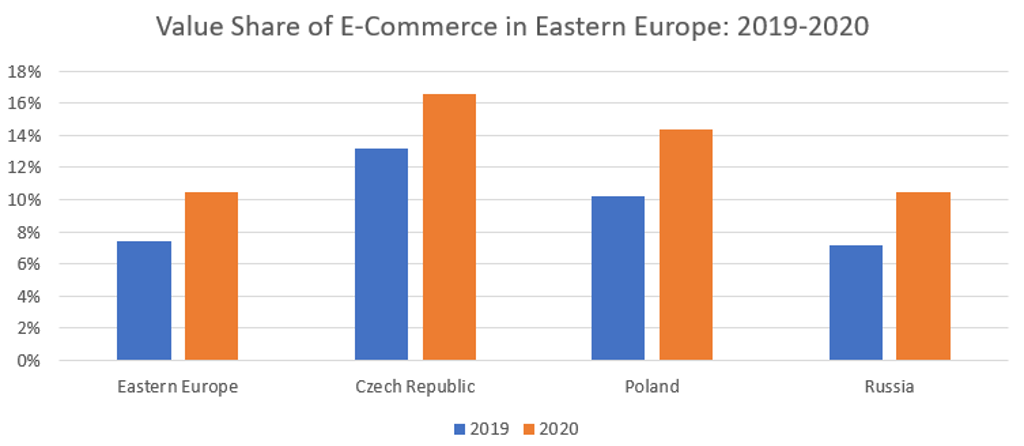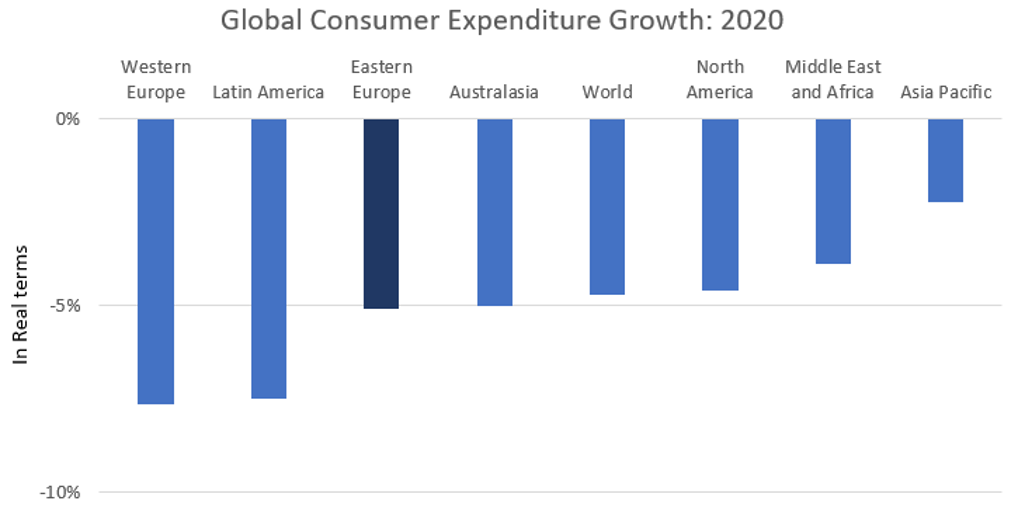As Euromonitor’s Global Consumer Trends 2021 show, Coronavirus (COVID-19) has had a profound impact on consumer behaviour, forcing businesses to readjust strategies and accommodate newfound demand. While the pandemic has shaped trends on a global level, there are often regional variations and notable differences in consumer response within these broad patterns. Our team of specialists in Vilnius have identified two of Euromonitor’s Global Consumer Trends which are having the biggest impact on Eastern Europe.
Craving Convenience: Expansion of delivery infrastructure and at-home experiences across Eastern Europe
Prior to the pandemic, the Eastern European purchasing pattern involved frequent visits to local shops and restaurants. Lockdown disrupted this pattern as people made fewer trips to physical stores and the major grocery companies adapted their operations to focus more on online sales and promotions.
The leading online retailers like Wildberries in Russia and Grupa Allegro in Poland have rapidly expanded their product assortment, tapping into grocery, and increasing operations through new logistic centres to manage growing demand. Significant investment in infrastructure in the form of self-service pick-up points across the region has played a big role in Wildberries’ success, providing a cheaper alternative to home delivery, with pick-up points within walking distance of residential areas. It is worth noting that Wildberries expanded its network of pick-up points from 7,500 to 26,000 in 2020. Other companies have partnered with local postage service providers, which have in turn expanded their own postal pick-up infrastructure.
Source: Euromonitor International
While consumers flocked to e-commerce during lockdown, the restaurant experience also evolved in several ways. Food delivery platforms across Eastern Europe have seen a surge in demand, as consumers seek a convenient on-trade experience. Newfound demand has pushed companies to expand their network of delivery drivers, while others, such as Yandex in Russia, were able to reassign their taxi drivers as travel decreased. As it becomes more expensive to order food from restaurants on a daily basis, new services utilising meal kits, adorned with pictures of fancy ingredients and easy-to-prepare instructions, were increasingly manifest, with notable examples such as Chefmarket and Yandex.Chef in Russia, which have emerged as inexpensive alternatives, in addition to saving time and effort in preparing food.
Thoughtful Thrifters: Pandemic catalyses frugal mindset in Eastern Europe
Pre-pandemic, disposable incomes in Eastern Europe were typically lower than the global average, meaning consumers already had a price-conscious mindset. The pandemic has exacerbated this trend due to the financial uncertainty related to jobs and economic outlook. In 2020 Eastern Europe saw the third biggest contraction in consumer expenditure globally, at 5% in real terms.
Source: Euromonitor International from national statistics/Eurostat/UN/OECD
While historically Eastern Europe has lagged behind more economically-developed regions, prior to the pandemic it was on a rising trajectory, gaining on the advanced economies of Western Europe. However, even while economic indicators improved, consumer spending habits were slower to evolve, partially due to a low level of trust in banks. As a result, in the more financially volatile countries like Russia and Ukraine, the average consumer was already relatively thrifty and frugal. Businesses were already having to cater to prudent consumers – a process catalysed by the pandemic.
In 2021, Eastern Europeans are looking for value but preferably without compromising too much on quality. For example, when it comes to consumer appliances, the market is becoming increasingly fragmented as bigger brands are losing ground to cheaper alternatives, mainly Chinese companies such as Haier Group. Major brands were also quick to adapt, as companies like Apple launched cheaper options within their iPhone lineup, while economy brand Xiaomi is taking market share from Huawei. Consumers are also choosing advanced varieties of LCD screens such as QLED, which provides high picture quality, but is cheaper than OLED technology. In order to fund these purchases, more retailers are offering interest-free credit - “buy now, pay later”. This option has helped businesses to increase the basket size of previously cautious thrifters. Whilst in non-discretionary industries, such as packaged food, market players were forced to intervene with promotional offers to dampen price increases caused by the global pandemic.
Demand for money and time savings to drive e-commerce
The trends showcased here illustrate an increasing necessity for businesses to tailor their solutions, services and products to meet Eastern European markets. Convenience-driven consumers are looking for easy-to-use solutions with the added benefit of seamless delivery of goods, while the on-going financial uncertainty has had a further impact on consumer purchasing power and priorities. As economies begin to recover following the decline in infection rates and vaccine distribution, Euromonitor’s Global Consumer Trends showcase the need for swift adaptability and resilience in this new environment, and to capitalise on the growth opportunities clearly emerging: looking ahead to 2022 and beyond, the drive to save time and money will see e-commerce almost double in value by the end of 2025.
Learn more about the trends Craving Convenience and Thoughtful Thrifters from our Top 10 Global Consumer Trends 2021 white paper.


